
Perverse Incentive: Hourly Pay Plus Piece-Rate Bonus
Gregorio Billikopf, University of California
Celina Lemus, California Endive Farms packing shed Production Manager

The California Endive Farms packing shed successfully moved away from the hourly pay plus piece-rate bonus compensation system they had ten years ago, one that caused high dissatisfaction among the packers, into a straight piece rate pay system that increased worker productivity, pay and satisfaction-and also augmented packing shed profitability.
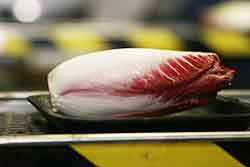
Growers who are worried that paying by the piece will mean shoddy work, and that paying by the hour will mean slow work, have come up with an apparently astute compromise: hourly paid work plus a piece-rate bonus. We, however, call it the perverse incentive because as employees' productivity increases, workers receive diminishing pay for their efforts. Workers are paid the most for the first unit of output, and decreasingly for each subsequent unit. As a result, faster workers subsidize slower ones. Workers are not motivated by this corrupted piece-rate approach, and often share their dissatisfaction. Or, just as likely, they simply work as if they were being paid by the hour. To complicate matters, a misunderstanding of the 2013 California rulings that require that employers pay rest breaks for piece-rate workers is also pushing some growers towards an hourly pay plus piece-rate bonus, or the perverse incentive.
The wonderful news is that workers are motivated by a properly designed piece rate. And that there are other methods for successfully complying with the new rest break regulations. Such as simply adding the equivalent of the two ten-minute break periods to the daily paycheck. Or paying the equivalent for what employees would have earned if they had kept working during the break.
Packing White Endives
The plants are first grown in the field, harvested and stored for up to eleven months and the delicate root is then placed in a completely dark room with just the right temperature and humidity. Small variations in temperature and humidity can have serious adverse effects on the process.
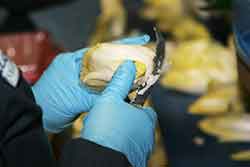
Several teams of four women sort and pack endives at the California Endive Farms. In 2004, the employees made their dissatisfaction with the hourly pay plus piece rate bonus clear. They wrote management: "Please remove the weight from off our shoulders and change the way you pay." The letter signed by all packers went on to suggest that the wages should be raised and the perverse incentive eliminated. At the time, the base pay was $7.25 an hour for up to 75 pounds of produce handled per hour. The bonus began with production over the 75 pound base, and consisted of 5.5 cents per pound (Figure 1). All pay mentioned in this paper is pre-tax.
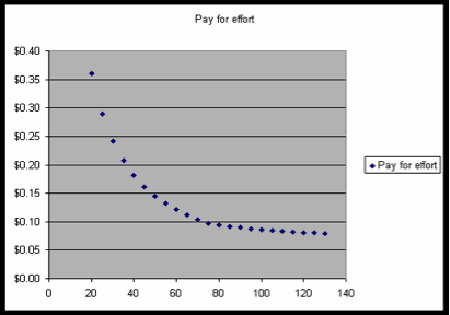
In his classic book Compensation Administration (1974), David Belcher-speaking about another piece-rate scheme-said: "Under the plan, wages increase with output but at a decreasing rate, and, regardless of output, it is impossible for an employee to make more than twice the hourly rate" (p. 321). Belcher's words can well be applied to any incorrectly applied piece rate system, including the perverse incentive. Over the years there has been way too much effort trying to work out some scheme or another rather than designing a straight piece rate that rewards employees fairly for their effort and benefits both employee and employer in the long run.
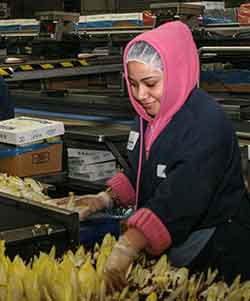
Figure 2 is an example of earning lines for those on a straight piece rate versus those on an hourly wage plus piece-rate bonus and shows how the faster workers (those who would have earned much more on a straight piece rate) subsidize the slower ones (those who would have earned much less on a straight piece rate).
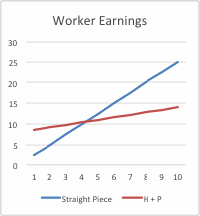
Moving to a Straight Piece Rate
Four of the most vital piece-rate principles include: (1) protecting employees from piece-rate games played by management (including the perverse incentive); (2) protecting management from poor quality work and activities that benefit employees at the expense of the farm enterprise; (3) designing a pay for performance approach that rewards employees for their effort, or what is under their control; and (4) involving workers in the decision-making process.
The new program began February 2005, after some of the more vocal packers had a chance to review the suggested changes and make suggestions for implementation. Some of the endive roots that employees handle take considerably less effort to trim and pack than others. As a result, a multi-tier approach was designed. The best quality endives would be paid at 8 cents per pound. Those endives that would require more work were to be paid at either 9 or 10 cents per pound. The goal of the field and storehouse managers is to produce as much of the top quality endive as possible.
For roots that did not meet any of these three quality grades, work would be done by the hour at the standard $7.50 per hour wage. (Beside the white endives discussed in this paper, at that time red and organic endives were paid by the hour. Today all pick/pack work is by the piece.) In 2013, these wages range from 9.3 to 11.6 cents per pound.
But packers did not make a smooth transition into the straight piece rate as there were residual trust issues, especially during the first few months. Feelings of distrust loomed large during the transition period which was characterized by continual complaints, anxiety on the part of the employees, and sabotage of the new system (for a month some of the women decided to work at the same pace to prove the system wrong). By 2006 the packers were pleased with working conditions and from time to time informally approached management to let them know that things were much better. That they could make more money in less hours and that they could spend more time with their families. In fact, employees were so satisfied with their jobs that there was virtually no turnover.
Because the second author kept excellent data from the time she began her job, data was available to be analyzed beginning with September 2002. This has permitted us to present before-and-after measures and trend comparisons.
On a sample day in 2013, the lowest performing group earned $18.45 per-person-per-hour, and the highest, $22.54, both well over double the minimum wage. The packing shed was able to increase profitability and end up with a very positive return on investment (ROI).
Using multiple regression, statistical analyses was carried out with pounds processed per hour (total pounds divided by total number of person-hours) as the dependent variable or productivity measure. Independent variables included average pounds per tray, addition of new equipment, and change in compensation (from hourly plus piece-rate to straight piece rate). The new pay system had a statistically significant, positive effect on worker productivity.
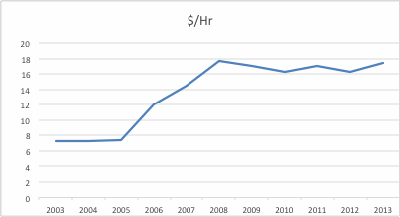
We calculated an ROI of 254%, that is, a benefit/cost ratio of 2.5:1 (a gain of $2.5 per $1 invested). Before February 2005, endives processed seldom surpassed 90 pounds per person-hour. It was thought by management that a barrier of 120 pounds per hour could not be broken. Yet, within a few months this barrier was shattered (Figure 4).
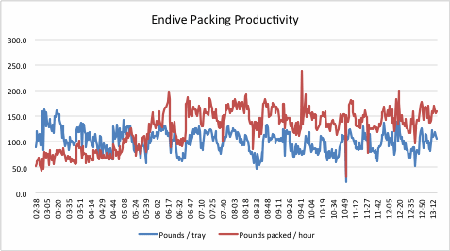
This study shows that worker productivity can increase when people are rewarded for their efforts.
Gregorio Billikopf is a labor management farm advisor for the University of California. He may be reached at gebillikopf@ucdavis.edu. Celina Lemus is a Production Manager at the endive packing shed, clemus@endive.com.
1.27.2014